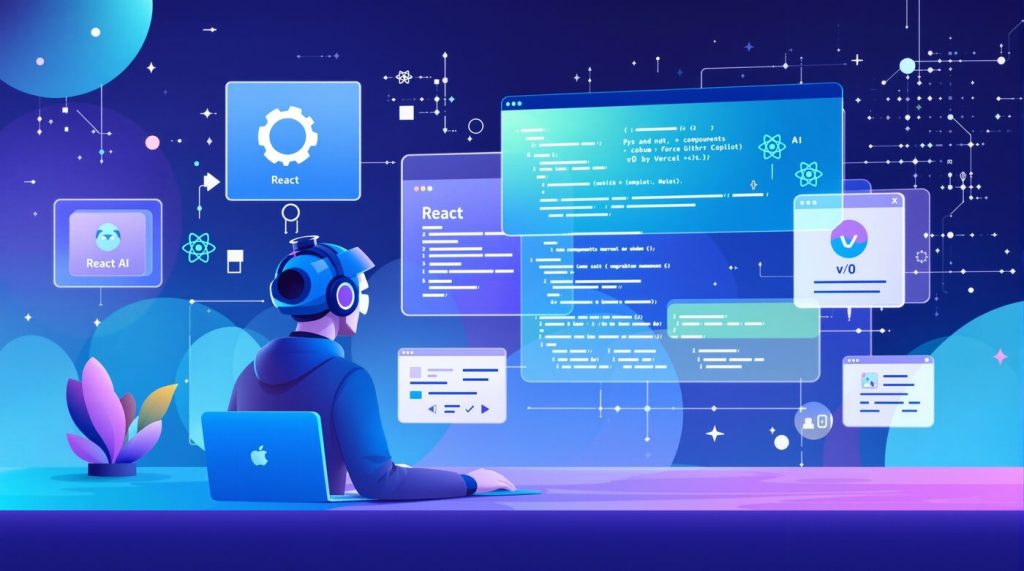
The web development landscape is experiencing its most dramatic transformation since the advent of responsive design. As we navigate through 2025, artificial intelligence isn’t just assisting developers—it’s fundamentally reshaping how we approach building for the web. With groundbreaking statistics revealing that 71.7% of new websites now use human-edited AI code and predictions that 90% of all code will be AI-generated by 2026, we’re witnessing a paradigm shift that every developer, business owner, and tech enthusiast needs to understand.
The AI Development Revolution: By the Numbers
The statistics paint a compelling picture of an industry in rapid transformation. According to recent data from Hostinger’s comprehensive analysis, developers wrote an astounding 256 billion lines of code in 2024, with projections reaching 600 billion lines in 2025. But here’s the kicker: only 59% of all code online is currently generated by humans, indicating that AI has already become a significant contributor to our digital infrastructure.
Perhaps most striking is that 2.5% of websites were created entirely using AI tools in 2025, representing millions of functional websites built without traditional hand-coding. This isn’t just about simple landing pages—these are sophisticated web applications that demonstrate AI’s growing capability to handle complex development tasks.
The Game-Changing AI Tools Transforming Web Development
1. GitHub Copilot: The AI Pair Programmer
GitHub Copilot has established itself as the most widely adopted AI coding assistant, functioning as an intelligent pair programmer that suggests entire functions, classes, and even complex algorithms in real-time. What sets Copilot apart is its ability to understand context from comments and existing code, generating solutions that align with your project’s architecture and coding style.
Key capabilities:
- Real-time code completion across multiple programming languages
- Contextual suggestions based on your codebase
- Integration with popular IDEs including VS Code, JetBrains, and Neovim
- Support for over 30 programming languages
2. v0 by Vercel: UI Generation at Lightning Speed
V0 by Vercel represents a breakthrough in AI-powered UI development. This tool specializes in generating production-ready React components from simple text prompts, making it possible to create sophisticated user interfaces without writing a single line of code initially.
Revolutionary features:
- Natural language to React component generation
- Tailwind CSS styling integration
- Real-time preview and iteration capabilities
- Export to Next.js projects
- Figma design import functionality
3. Cursor: The AI-First Code Editor
Cursor has emerged as a powerful alternative to traditional code editors, built from the ground up with AI integration. It combines the familiar feel of VS Code with advanced AI capabilities that go beyond simple autocomplete.
Advanced capabilities:
- Intelligent code refactoring suggestions
- Bug detection and automatic fixes
- Natural language code generation
- Context-aware documentation generation
The Business Impact: Speed, Efficiency, and Innovation
The adoption of AI-powered development tools is delivering tangible business benefits that extend far beyond faster coding:
Accelerated Development Cycles
Traditional web development projects that once took months are now being completed in weeks. AI tools handle routine coding tasks, allowing developers to focus on architecture, user experience, and business logic. This acceleration is particularly valuable for startups and businesses needing rapid digital presence establishment.
Democratized Web Development
AI tools are lowering the barrier to entry for web development. Non-technical team members can now contribute to the development process using tools like v0, while experienced developers can tackle more complex projects with AI assistance.
Enhanced Code Quality
Modern AI tools don’t just write code—they write better code. They incorporate best practices, security considerations, and performance optimizations that might be overlooked in manual development. This results in more maintainable, secure, and efficient web applications.
Real-World Applications: AI in Action
E-commerce Platform Development
A mid-sized retail company recently used v0 to prototype their entire e-commerce interface in just two days. What traditionally would have required a team of frontend developers working for weeks was accomplished by a single developer using AI-generated components as a starting point.
SaaS Dashboard Creation
A fintech startup leveraged GitHub Copilot to build their complex analytics dashboard, reducing development time by 60% while maintaining high code quality standards. The AI assistant helped generate data visualization components, API integration logic, and responsive design implementations.
Content Management Systems
Several agencies are now using AI tools to rapidly develop custom CMS solutions for clients, with AI handling the routine CRUD operations, authentication systems, and admin interfaces while developers focus on unique business requirements.
Challenges and Considerations
While the benefits are substantial, the AI development revolution comes with important considerations:
Code Quality and Security
Despite AI’s impressive capabilities, human oversight remains crucial. AI-generated code requires careful review for security vulnerabilities, performance issues, and alignment with project requirements. The statistic that 20% of websites encounter security vulnerabilities during development underscores the importance of maintaining rigorous code review processes.
Dependency and Skill Development
There’s a growing concern about over-reliance on AI tools potentially leading to skill atrophy among developers. Balancing AI assistance with fundamental programming knowledge remains essential for long-term career development.
Cost Considerations
While AI tools can reduce development time, they often come with subscription costs. Teams need to evaluate the ROI of AI tool investments against traditional development approaches.
The Future Landscape: What’s Coming Next
As we look toward 2026 and beyond, several trends are shaping the future of AI-powered web development:
Autonomous Development Agents
The next generation of AI tools will function as autonomous development agents capable of understanding high-level requirements and implementing complete features with minimal human intervention.
Natural Language Programming
We’re moving toward a future where complex web applications can be built using natural language descriptions, making web development accessible to anyone who can clearly articulate their requirements.
AI-Powered Testing and Optimization
Future AI tools will automatically generate comprehensive test suites, perform accessibility audits, and optimize performance without human intervention.
Getting Started: Practical Steps for Adoption
For developers and businesses looking to embrace AI-powered development:
For Individual Developers:
- Start with GitHub Copilot to experience AI-assisted coding
- Experiment with v0 for rapid UI prototyping
- Learn to write effective prompts for AI tools
- Maintain a balance between AI assistance and manual coding skills
For Development Teams:
- Conduct pilot projects using AI tools to assess ROI
- Establish code review processes for AI-generated code
- Invest in team training for AI tool utilization
- Develop guidelines for when and how to use AI assistance
For Businesses:
- Evaluate AI tools’ potential impact on project timelines
- Consider the competitive advantage of faster development cycles
- Assess security and compliance requirements for AI-generated code
- Plan for the changing skill requirements in development teams
Conclusion: Embracing the AI-Powered Future
The integration of AI into web development isn’t just a trend—it’s a fundamental shift that’s reshaping how we build for the web. With 71.7% of new websites already leveraging AI-generated code and projections showing 90% AI-generated code by 2026, the question isn’t whether to adopt these tools, but how quickly and effectively you can integrate them into your development workflow.
The developers and businesses that embrace this transformation now will have a significant competitive advantage in speed, efficiency, and innovation capability. However, success will require thoughtful adoption, maintaining the balance between AI assistance and human expertise, and continuous learning to keep pace with rapidly evolving tools and capabilities.
As we stand at the threshold of this AI-powered development era, one thing is clear: the future of web development is collaborative, where human creativity and strategic thinking work hand-in-hand with AI’s computational power and pattern recognition capabilities. The question isn’t whether AI will transform web development—it’s how we’ll shape that transformation to create better, faster, and more innovative web experiences.
The statistics and insights in this article are based on the latest industry research from Hostinger, GitHub, Vercel, and other leading technology companies as of September 2025.




